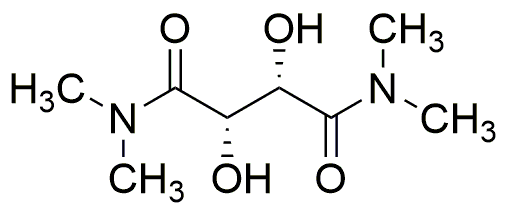(-)-N,N,N',N'-Tetramethyl-D-tartardiamide is widely utilized in research focused on
- Chiral Separation: This compound is effective in chiral chromatography, helping researchers separate enantiomers in pharmaceuticals, which is crucial for developing safe and effective drugs.
- Asymmetric Synthesis: It plays a vital role in asymmetric synthesis, allowing chemists to produce specific stereoisomers of compounds, enhancing the efficiency of drug development.
- Biochemical Studies: Used in studies involving enzyme reactions, it helps in understanding enzyme mechanisms and interactions, which is essential for biochemistry research.
- Polymer Chemistry: Its properties make it suitable for creating polymers with specific characteristics, benefiting industries like plastics and coatings.
- Analytical Chemistry: This compound aids in the development of analytical methods for detecting and quantifying substances, improving accuracy in various chemical analyses.
Informations générales
Propriétés
Sécurité et réglementation
Applications
(-)-N,N,N',N'-Tetramethyl-D-tartardiamide is widely utilized in research focused on
- Chiral Separation: This compound is effective in chiral chromatography, helping researchers separate enantiomers in pharmaceuticals, which is crucial for developing safe and effective drugs.
- Asymmetric Synthesis: It plays a vital role in asymmetric synthesis, allowing chemists to produce specific stereoisomers of compounds, enhancing the efficiency of drug development.
- Biochemical Studies: Used in studies involving enzyme reactions, it helps in understanding enzyme mechanisms and interactions, which is essential for biochemistry research.
- Polymer Chemistry: Its properties make it suitable for creating polymers with specific characteristics, benefiting industries like plastics and coatings.
- Analytical Chemistry: This compound aids in the development of analytical methods for detecting and quantifying substances, improving accuracy in various chemical analyses.
Documents
Fiches de données de sécurité (FDS)
La FDS fournit des informations de sécurité complètes sur la manipulation, le stockage et l’élimination du produit.
Spécifications du produit (PS)
Le PS fournit une description complète des propriétés du produit, notamment sa composition chimique, son état physique, sa pureté et les exigences de stockage. Il détaille également les plages de qualité acceptables et les applications prévues du produit.
Certificats d'analyse (COA)
Recherchez des certificats d'analyse (COA) en saisissant le numéro de lot du produit. Les numéros de lot et de lot se trouvent sur l'étiquette d'un produit, après les mots « Lot » ou « Lot de fabrication ».
Numéro de catalogue
Numéro de lot/série
Certificats d'origine (COO)
Ce certificat d'exploitation confirme le pays dans lequel le produit a été fabriqué, et détaille également les matériaux et composants utilisés et s'il est issu de sources naturelles, synthétiques ou autres sources spécifiques. Ce certificat peut être requis pour les douanes, le commerce et la conformité réglementaire.
Numéro de catalogue
Numéro de lot/série
Fiches de données de sécurité (FDS)
La FDS fournit des informations de sécurité complètes sur la manipulation, le stockage et l’élimination du produit.
DownloadSpécifications du produit (PS)
Le PS fournit une description complète des propriétés du produit, notamment sa composition chimique, son état physique, sa pureté et les exigences de stockage. Il détaille également les plages de qualité acceptables et les applications prévues du produit.
DownloadCertificats d'analyse (COA)
Recherchez des certificats d'analyse (COA) en saisissant le numéro de lot du produit. Les numéros de lot et de lot se trouvent sur l'étiquette d'un produit, après les mots « Lot » ou « Lot de fabrication ».
Numéro de catalogue
Numéro de lot/série
Certificats d'origine (COO)
Ce certificat d'exploitation confirme le pays dans lequel le produit a été fabriqué, et détaille également les matériaux et composants utilisés et s'il est issu de sources naturelles, synthétiques ou autres sources spécifiques. Ce certificat peut être requis pour les douanes, le commerce et la conformité réglementaire.

